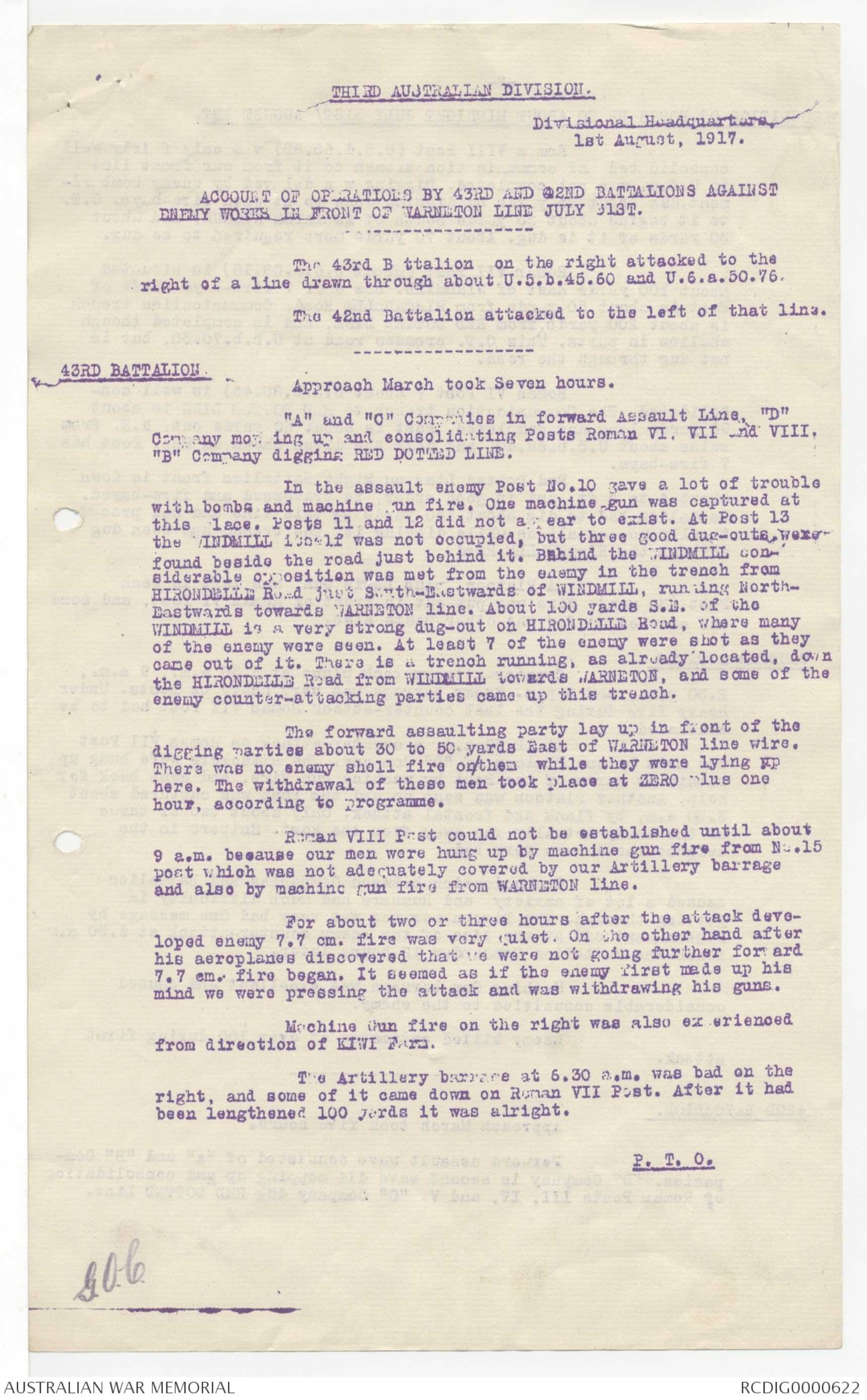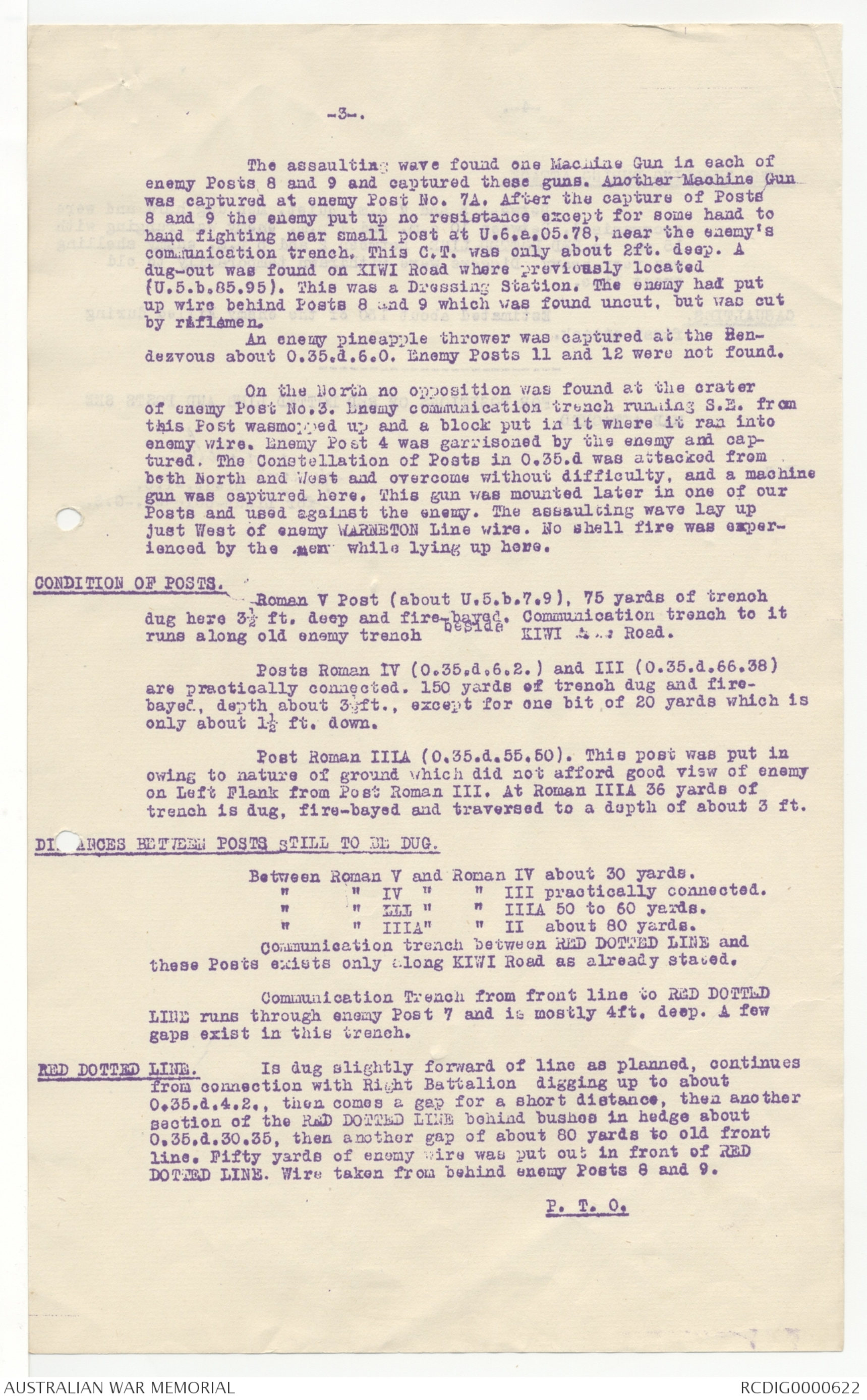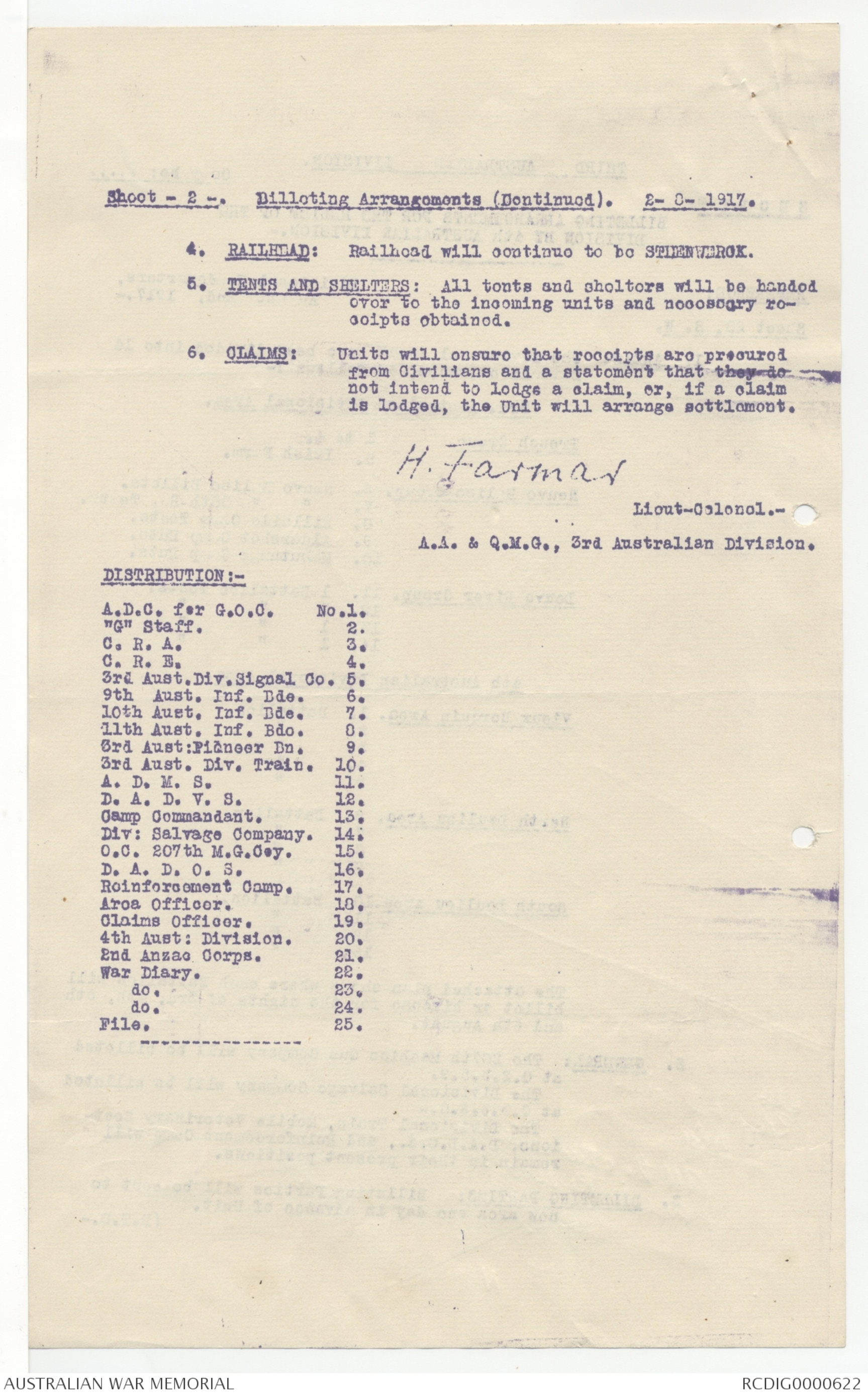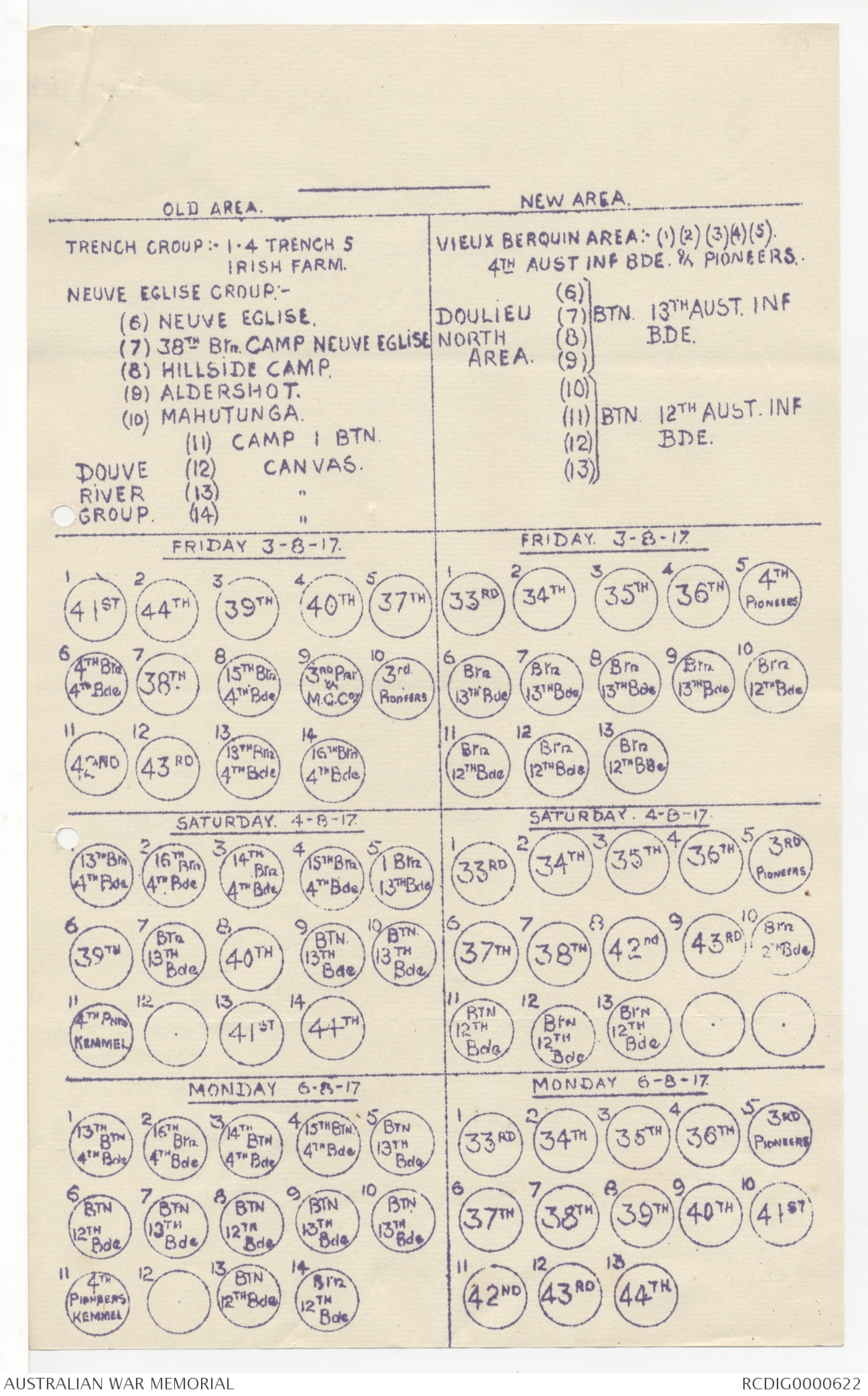Sir John Monash, Personal Files Book 16, 1 August - 3 September 1917, Part 2










Army's infantry and machine guns, whatever they may be, and for
t s I think the Field Artillery barrage might be thinned.
(iv) The first "waves"of infantry which immediately follow
the barrage should be very thin and the numbers of 'moppers up"
proportionately increased.
(v) The ground over which the barrage and the first waves
ha e passed should be divided into well defined areas, the numbers
of moppers up for each area very carefully calculated beforehand
and allotted and each area given to a particular commander
responsible for the clearing of the whole area.
(vi) This officer must never fail to send reports in to his
superior not only when he has completed the "clearing"of his area,
but frequently while this is in progress and certainly every time
the barrage"lifts" after a halt.
(vii) It should be clearly understood that a line can be
considered to be "held" not when it is in occupation of our
advanced troops but when the whole area behind it has been cleared.
(viii) Very definite instructions must be given to commanders
of units on the flanks of formations. In all orders a point of
junction is given and the duty of securing it allotted to a unit.
It is of course the duty of the commander of that unit to secure
the point if he can, but if for any reason he fails to do so at
the time appointed it is the duty of the commander of the other
unit to endeavour to do so.
This must be made very clear to all officers.
(ix) Orders given to and by commanders for the occupation
of any position, however small, should invariably include the
measures to be taken to meet a counter attack.
Counter attacks, unless overwhelming, can nearly always
be defeated of if the defenders are prepared for them.
(x) It cannot be too strongly impressed on young officers
and non-commissioned officers who are detached from their superior
commanders that it is far better if they are attacked, either to
remain in a position if they have been placed in it or to make
a bold forward movement. They will thus not only be best
fulfilling their instructions but also be more likely to ensure
the safety of the men under them than by any withdrawal.
(sd) Herbert Plumer, General
Commanding Second Army.
-2-
2nd ANZAC
No. S.G. 527.
2nd August, 1917.
Major-General J.Monash, C.B.,V.D.,
Commanding 3rd Aust. Division
Copy of the Army Commanders's minute on Second Army
operations of July 31 forwarded for your information.
(signature) CW Gwynn
B.G.,G.S.,
2nd ANZAC Corps.
THIRD AUSTRALIAN DIVISION.
Divisional Headquarters,
1st August, 1917.
ACCOUNT OF OPERATIONS BY 43RD AND 42ND BATTALIONS AGAINST
ENEMY WORKS IN FRONT OF WARNETON LINE JULY 31ST.
The 43rd B ttalion on the right attacked to the
right of a line drawn through about U.5.b.45.60 and U.6.a.50.76.
The 42nd Battalion attacked to the left of that line.
43RD BATTALION
Approach March took Seven hours.
"A" and "C" Companies in forward Assault Line, "D"
Company moving up and consolidating Posts Roman VI, VII and VIII,
"B" Company digging RED DOTTED LINE.
In the assault enemy Post No.10 gave a lot of trouble
with bombs and machine gun fire. One machine gun was captured at
this place. Posts 11 and 12 did not appear to exist. At Post 13
the WINDMILL itself was not occupied, but three good dug-outs were
found beside the road just behind it. Behind the WINDMILL considerable
opposition was met from the enemy in the trench from
HIRONDELLE Road just South-Eastwards of WINDMILL, running North-Eastwards
toward WARNETON line. About 100 yard S.E. of the
WINDMILL is a very strong dug-out on HIRONDELLE Road, where many
of the enemy were seen. At least 7 of the enemy were shot as they
came out of it. There is a trench running, as already located, down
the HIRONDELLE Road from WINDMILL towards WARNETON, and some of the
enemy counter-attacking parties came up this trench.
The forward assaulting party lay up in front of the
digging parties about 30 to 50 yards East of WARNETON line wire.
There was no enemy shell fire on/them while they were lying up
here. The withdrawal of these men took place at ZERO plus one
hour, according to programme.
Roman VIII Post could not be established until about
9 a.m. because our men were hung up by machine gun fire from No.15
post which was not adequately covered by out Artillery barrage
and also by machine gun fire from WARNETON line.
For about two or three hours after the attack developed
enemy 7.7 cm. fire was very quiet. On the other hand after
his aeroplanes discovered that we were not going further forward
7.7 cm. fire began. It seemed as if the enemy first made up his
mind we were pressing the attack and was withdrawing his guns.
Machine Gun fire on the right was also experienced
from direction of KIWI Farm.
The Artillery barrage at 6.30 a.m. was bad on the
right, and some of it came down on Roman VII Post. After it had
been lengthened 100 yards it was alright.
P. T. O.
G.O.C.
-2-
CONDITION OF POSTS UP TO ABOUT MIDNIGHT JULY 31ST/ AUGUST 1ST.
Roman VIII Post (U.5.d.65.82) was only fairly well
consolidated and communication trench to it from our front line
in U.5.d, was not completed. Digging was delayed by enemy bombardment.
Has about 25 yards of digging done to it with fire-bays. C.T.
to it begins about 30 yards South of ADELAIDE AVENUE, and about
30 yards of it is dug. About 70 yards more required to be dug.
Roman VII Post (about U.6.a.08.18) is situated
about 100 yards East of WINDMILL. Has 6 or 7 fire-bays. Left of
Post is about 50 yards from HIRONDELLE Road. Communication trench
is about 200 yards ^long from RED DOTTED LINE, and is completed though
shallow in parts. This C.T. crosses road at U.5.b.70.30, but is
not dug through the road.
Roman VI Post ( about U.5.b.80.45) is well consolidated.
The Communication trench to RED DOTTED LINE is about
90 yards long and completed. Post is about 80 yards out, N.E. from
ruins about U.5.b.68.40, and near the ditch shewn on Map. Post has
7 fire-bays.
Red Dotted Line on Right Battalion front is down
about 4 to 5 ft. and in good order, is traversed and fire-bayed.
Battalion had to dig about 150 yards of this line and had practically
no casualties while digging it. The trench has been dug
through the HIRONDELLE Road.
A Platoon, plus Lewis Gun, was left in each
Post (30 men). Wire was put out in front of Roman VI Post, and some
was carried up for the other posts also.
COUNTER-ATTACKS.
Counter-attacks took place at 6.30 a.m., 9 a.m.,
2.30 p.m., and 9 p.m. Enemy barrage was very heavy on Posts. Under
heavy fire during the last counter-attack Roman VII Post had to be
evacuated.
At 12.30 a.m. a counter-attack on Roman VII Post
was made by one Platoon of "D" Company. The attackers were hung up
within 40 yards of the Post by machine gun fire, and sent back for
help. Another Platoon was sent up and the Post was captured about
3.30 a.m. by flank and frontal attack. Only about two or three
of the enemy actually ran away from the Post. Snipers in the
neighbourhood were very bad.
Communication between Companies and Battalion
caused a lot of anxiety and Runners had much difficulty in
getting through. The Pigeon service was very bad One message by
Pigeon sent off at the time of the enemy counter-attack at 6.30 a.m.
reach the Battalion Commander 12 hours later.
Machine Gun barrage was excellent and caused
considerable casualties to the enemy.
Enemy killed estimated at over 100 during first
attack.
42ND BATTALION
Approach March took five hours.
Forward assault wave consisted of "A" and "B" Companies.
"D" Company in second wave did mopping up and consolidation
of Roman Posts III, IV, and V. "C" Company dug RED DOTTED Line.
-3-.
The assaulting wave found one Machine Gun in each of
enemy Posts 8 and 9 and captured these guns. Another Machine Gun
was captured at enemy Post No. 7A. After the capture of Posts
8 and 9 the enemy put up no resistance except for some hand to
hand fighting near small post at U.6.a.05.78, near the enemy's
communication trench. This C.T. was only about 2ft. deep. A
dug-out was found on KIWI Road where previously located
(U.5.b.85.95). This was a Dressing Station. The enemy had put
up wire behind Posts 8 and 9 which was found uncut, but was cut
by riflemen.
An enemy pineapple thrower was captured at the Rendezvous
about 0.35.d.6.0. Enemy Posts 11 an 12 were not found.
On the North no opposition was found at the crater
of enemy Post No.3. Enemy communication trench running S.E. from
this Post wasmopped up and a block put in it where it ran into
enemy wire. Enemy Post 4 was garrisoned by the enemy and captured.
The Constellation of Posts in 0.35.d was attacked from
both North and West and overcome without difficulty, and a machine
gun was captured here. This gun was mounted later in one of our
Posts and used against the enemy. The assaulting wave lay up
just West of enemy WARNETON Line. No shell fire was experienced
by the men while lying up here.
CONDITIONS OF POSTS.
Roman V Post (about U.5.b.7.9), 75 yards of trench
dug here 3½ ft. deep and fire-bayed. Communication trench to it
runs along old enemy trench beside KIWI [[?]] Road.
Posts Roman IV (0.35.d.6.2. ) and III (0.35.d.66.38)
are practically connected. 150 yards of trench dug and fire-bayed,
depth about 3 ft., except for one bit of 20 yards which is
only about 1½ ft. down.
Post Roman IIIA (0.35.d.55.50). This post was put in
owing to nature of ground which did not afford good view of enemy
on Left Flank from Post Roman III. At Roman IIIA 36 yards of
trench is dug, fire-bayed and traversed to a depth of about 3 ft.
DISTANCES BETWEEN POSTS STILL TO BE DUG.
Between Roman V and Roman IV about 30 yards.
" " IV " " III practically connected.
" " III " " IIIA 50 to 60 yards.
" " IIIA" " II about 80 yards.
Communication trench between RED DOTTED LINE and
these Posts exists only along KIWI Road as already stated.
Communication Trench from front line to RED DOTTED
LINE runs through enemy Post 7 and is mostly 4ft. deep. A few
gaps exist in this trench.
RED DOTTED LINE. Is dug slightly forward of line as planned, continues
from connection with Right Battalion digging up to about
0.35.d.4.2., then comes a gap for a short distance, then another
section of the RED DOTTED LINE behind bushes in hedge about
0.35.d.30.35, then another gap of about 80 yards to old front
line. Fifty yards of enemy wire was put out in front of RED
DOTTED LINE. Wire taken from behind enemy Posts 8 and 9.
P. T. O.
-4-.
ENEMY SHELLING DURING ATTACK.
Between 5 and 7 a.m. quiet. Men dug hard and were
reorganised. Between 10 a.m. and 1 p.m. enemy was ranging with
15 cm. on RED DOTTED LINE. Between 2 and 5 p.m. enemy shelling
was very heavy. Diggers were withdrawn temporarily to old
front line.
CASUALTIES. Estimated about 150 of the enemy killed during
first attack.
FOR POSITIONS OF RED DOTTED LINE AND POSTS SEE
MAP ATTACHED.
T.C.
(signature)
Lieut.-I.C.
for Lieut-Colonel.-G.S.
THIRD AUSTRALIAN DIVISION.
Copy No: 1....
S E C R E T:
BILLETING ARRANGEMENTS FOR THE RELIEF OF THE
DIVISION BY 4TH AUSTRALIAN DIVISION.-
REFERENCE: Divisional Headquarters,
August 2nd, 1917.-
Sheet 28, S. W.
- AREAS: The Divisional Areas have been divided into 14
Battalion Groups, as follows :-
3rd. Australian Divisional Area.
Trench Group. 1 to 4.
5. Irish Farm.
Neuvo Eglise Group. 6. Neuvo Eglise Billets.
7. " " 38th Bn. Tents.
8. Hillside Camp Tents.
9. Aldershot Camp Huts.
10. Mahutunga Camp Huts.
Douve River Group. 11. 1 Battalion Tents.
12. 1 " "
13. 1 " "
14. 1 " "
4th Australian Divisional Area.
Vieux Berquin Area. 1. Battalion.
2. "
3. "
4. "
5. "
North Doulieu Area. 6. Battalion.
7. "
8. "
9. "
South Doulieu Area. 10. Battalion.
11. "
12 . "
13. "
The attached plan shows where each Battalion will
billet or bivouac for the nights of 3rd, 4th, 5th
and 6th August.
2. GENERAL: The 207th Machine Gun Company will be billeted
at G.2.b.5.9.
The Divisional Salvage Company will be billeted
G.3.b.6.8.-
The Divisional Train, Mobile Veterinary Sections,
D.A.D.O.S., and Reinforcement Camp will
remain in their present positions.
3. BILLETING PARTIES: Billeting Parties will be sent to
new area one day in advance of Unit.
(P.T.O.-
Sheet – 2 –. Billeting Arrangements (Continued). 2- 8- 1917.
4. RAILHEAD: Railhead will continue to be STEENWERCK.
5. TENTS AND SHELTERS: All tents and shelters will be handed
over to the incoming units and necessary receipts
obtained.
6. CLAIMS: Units will ensure that receipts are procured
from Civilians and a statement that they do
not intend to lodge a claim, or, if a claim
is lodged, the Unit will arrange settlement.
H. Farmar
Lieut-Colonel.-
A.A. & Q.M.G., 3rd Australian Division.
DISTRIBUTION :-
A.D.C. for G.O.C. No.1.
"G" Staff. 2.
C. R. A. 3.
C. R. E. 4.
3rd Aust. Div.Signal Co. 5.
9th Aust. Inf. Bde. 6.
10th Aust Inf. Bde. 7.
11th Aust. Inf. Bde. 8.
3rd Aust:Pioneer Bn. 9.
3rd Aust. Div. Train. 10.
A. D. M. S. 11.
D. A. A. V. S. 12.
Camp Commandant. 13.
Div: Salvage Company. 14.
O.C. 207th M.G.Coy. 15.
D. A. D. O. S. 16.
Reinforcement Camp. 17.
Area Officer. 18.
Claims Officer. 19.
4th Aust : Division. 20.
2nd Anzac Corps. 21.
War Diary. 22.
do. 23.
do. 24.
File. 25.
| OLD AREA | NEW AREA |
|
THRENCH GROUP :- 1 - 4 TRENCH 5 IRISH FARM NEUVE EGLISE GROUP:- (6) NEUVE EGLISE. (7) 38TH Btn. CAMP NEUVE EGLISE (8) HILLSIDE CAMP. (9) ALDERSHOT. (10) MAHUTUNGA. (11) CAMP 1 BTN. DOUVE (12) CANVAS RIVER (13) " GROUP. (14) " |
VIEUX BERQUIN AREA:- (1)(2)(3)(4)(5). 4TH AUST INF BDE. [[9h?]] PIONEERS. (6)\ DOULIEU (7) | BTN. 13TH AUST. INF NORTH (8) | B.D.E AREA. (9)/ (10)\ (11) | BTN. 12TH AUST. INF (12) | BDE. (13)/ |
|
FRIDAY 3-8-17.
|
FRIDAY 3-8-17.
|
|
SATURDAY 4-8-17.
|
SATURDAY 4-8-17.
|
|
MONDAY 6-8-17
|
MONDAY 6-8-17
|
[*Handed me by Gwynne
4/8/17*]
SECRET.
2nd ANZAC CORPS.
General Staff Circular No. 21.
3rd August, 1917.
1. During the operations of July 31st enemy shell hole
positions in some places on the Army front were not satisfactorily
dealt with. The assaulting waves were not accompanied
by strong enough mopping up parties to deal with the area
traversed.
2. Between LA BASSE VILLE and the River DOUVE the enemy
was found established in shell holes roofed with timber covered
with earth 8" deep strewn with thistles and grass. The shell
holes thus prepared were difficult to locate and had only small
entrances (generally in rear).
Although in this particular instance mopping up was
satisfactory, it took a considerable time and progress was slow.
3. When carrying out attacks against and through similar
positions in future, the following general principles should receive attention :-
(a) Pace of the barrage should be slow.
(b) The assaulting waves following the barrage through
the shell hole area may be kept thin, but they
must be accompanied or followed by strong mopping
up parties organised to deal with definite sections
of the shell hole area.
(c) The barrage should make well defined halts to assist
the distribution of the mopping up parties.
(d) Arrangements for the command of mopping up areas, and
for re-assembling and re-organising mopping up
parties, must be made.
(e) The clearance of areas must be reported in the same way
as the capture of definite objectives.
(signature) CW Gwynn
B.G.,G.S.,
2nd ANZAC Corps.
| Distribution :- | Copies |
| New Zealand Division. | 25 |
| 3rd Australian Division. | 25 |
| 4th Australian Division. | 25 |
| 4th N.Z.Inf. Bde | 7 |
| 2nd ANZAC Corps School. | 1 |
| G.O.C.,R.A. | 2 |
| C.M.G.O. | 1 |
THIRD AUSTRALIAN DIVISION.
Divisional Headquarters,
3rd. August, 1917.
G. C. C.,
Third Australian Division.
- - - - - - - - - - - - - - - -
I beg to make the following report :-
To-night, on receipt of Corps Order No. 72, I rang
up Lieut-Colonel COLLARD to ask his help in smoothing out
the problem of finding accommodation for the Division on its
relief.
I had worked out a scheme as soon as I was given
information by the G.S.O. I, on his return from the Corps
"G" Conference in the middle of the day, and had found a
solution, which, to be complete, depended upon the clearance
for us of the Waterlands Hutments Site.
I asked Colonel COLLARD if he could do this, and he
made difficulties. He did not appear to have considered
the question of accommodation at all, and said he thought the
Division was to go into the Berquin Area, and that it was
for the Division to find its own accommodation. I
suggested that the Division looked to "Q" Staff of Corps to
look ahead and provide for requirements in a change ordered
by the "G" Staff, which involved new areas. Colonel
COLLARD replied that he waited for orders from "G" Staff,
and then acted upon them. I stated that orders were
received from Corps at 9 p.m., to be carried out the next day,
which involved much reconnaissance and thinking over; that
it could not be left so late, to which Colonel COLLARD said,
that if I wished to criticise Corps Orders I could do so on
paper.
I told the G.S.O. I what had occurred, and he
telephoned to General GWYNNE. Later on Colonel COLLARD
 Sam scott
Sam scottThis transcription item is now locked to you for editing. To release the lock either Save your changes or Cancel.
This lock will be automatically released after 60 minutes of inactivity.